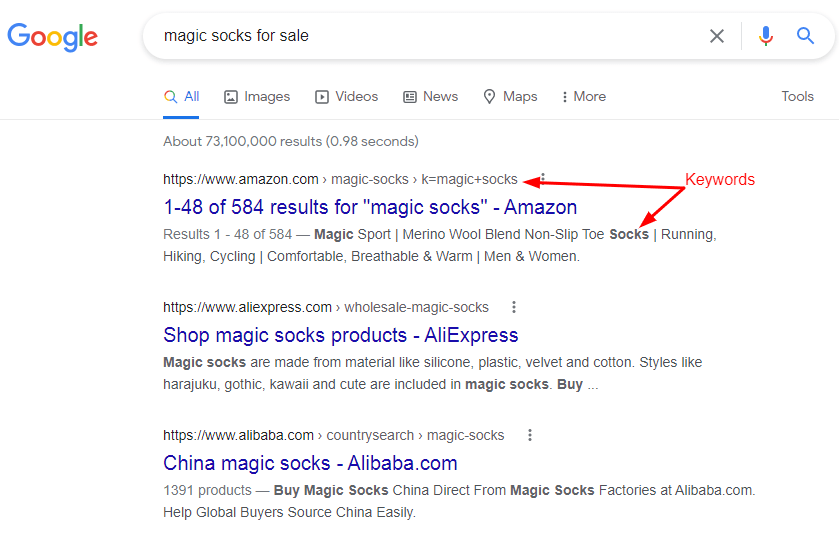Both SEO and SEM are crucial marketing techniques used to drive website traffic, capture the attention of potential customers, and build brand authority. But what exactly are SEO and SEM? And what’s the difference between the two?
SEO (or search engine optimization) is used to drive organic traffic to websites; that is, traffic you gain without paying for it. SEM (or search engine marketing) is a paid method of driving traffic, such as buying ads against target keyword searches.
In this guide, we’ll explain exactly what SEO and SEM are, how they work, and why they’re so important. We’ll then run a comparison of SEO vs SEM, helping you determine which to use and when.
Here’s a clickable menu in case you’d like to skip to specific sections.
- An introduction to SEO vs SEM
- What is SEO?
- What is SEM?
- What are the main differences between SEO and SEM?
- How are SEO and SEM similar?
- Key takeaways
Let’s explore SEO vs SEM!
1. SEO vs SEM: An introduction to search marketing
Have you ever had a sudden itch to find a plumber or a pair of purple magic socks? I’m guessing that’s a no on the plumber. Search marketing is what the owner of the website selling your soon-to-be magic pair of socks does to appear on the search engine (Google, Yahoo, Bing, etc). They can do that through SEO or SEM.
- SEO (search engine optimization) involves all the activities our magic socks retailer will do to get their socks website discovered by searchers organically (without having to pay the search engine to show their web page).
- SEM (search engine marketing) is the process of paying search engines to show the website on the search engine results pages (SERPs) when people are searching for magic socks.
So: SEM and SEO are both forms of search marketing with a similar end goal, but they work differently. Let’s explore each in more detail now, starting with SEO.

2. What is SEO?
Search Engine Optimization is a set of tactics used by website owners to get their websites to rank high on the Search Engine Results Page (SERP) organically. It’s how you get your website and other content to appear as one of the first results a user will see when they search for related terms. The primary search engines include Google, Baidu, Bing, Yahoo, Yandex, and DuckDuckGo.
According to Statcounter, an online visitor tracker, Google has 91.86% of the search engine market, hence why a majority of marketers’ conversations about SEO revolve around Google (we’ll do the same throughout this article).
For an in-depth look at SEO, check out our beginner’s guide.
What is SEO used for?
To understand SEO, we first have to understand the role of search engines like Google, whose primary job is to help online users find the most relevant information, in the shortest amount of time possible, with the least friction.
Google does this by crawling millions of websites looking for signals matching the intent of the searcher. Brands use SEO to improve those signals so that their websites are picked up, and shown to as many searchers as possible.
For example, if you type a search query of “Best French restaurants in London” into Google, Google will find the most relevant results and rank them accordingly.
Learn more: Best free SEO training courses
Why is SEO important?
According to Ahrefs, an SEO tool, 9 out of every 10 pages published online don’t get organic search traffic from Google. Furthermore, a 2020 study of 80 million keywords by Sistrix found that 28.5% of Google users click on the first organic result, with traffic decreasing significantly as you go down the ranking.
To stand out, businesses have to optimize their websites through SEO to rank higher than their competition. In the early days of Google, you did not have to do much to rank high, but with constant search engine algorithm improvements, good SEO (and SEO skills and knowledge) have grown in importance.
How does SEO work?
Let’s be practical! Here’s a screenshot of the search engine results that came up for my search for magic socks. Why do you think Google chose to show me these? Here’s a clue: the keywords here are “magic socks.”

In this search, Google crawled 73.1 million web pages in 0.98 seconds and picked the top three on the premise that they would be the most helpful to my search. This was based on multiple factors.
Search engines can also determine the search intent of the keywords used. For example, I included the transactional keyword, ‘sale’, in the search, indicating that I was not only looking for magic socks but wanted to buy them.
Google noticed this, and that’s why the top three search results in the SERP screenshot are all e-commerce websites instead of a ‘how to make magic socks’ tutorial.
Types of SEO
There are three ways to optimize for search engine crawlers. Each caters to the different signals that Google looks at while deciding which websites to rank, and in what order.
On-page SEO
On-page SEO refers to all the SEO elements you can control and optimize on a web page itself. This includes things like the written copy and content included in a page, headers, images, and image alt text. You’ll find a comprehensive list of on-page SEO ranking factors here.
In the screenshot of the magic socks SERP we covered earlier, all the ranking sites’ URLs and meta descriptions (the text that appears below the title) contain the keywords ‘magic socks’. The magic socks retailer has optimized their content for that keyword as part of their on-page SEO strategy.
Also, in this article, for instance, we’ve marked all the headings with either H1, H2, or H3 tags. This is the language that helps Google’s crawlers understand our content and how it’s structured.
Another on-page SEO factor Google looks at is how websites have used keywords within their content. They look at keyword volume and relevance.
Content marketers often have an understanding of on-page SEO, and will incorporate SEO best practices into their content as they create it.
Technical SEO
These are optimizations around the technical aspects of websites that affect their ranking, including mobile-friendliness, site loading time (Google recommends a loading time of 3 seconds or less), crawl errors, and presence of sitemaps. Technical SEO often lies in the realm of SEO specialists and web developers.
Off-page SEO
Off-page SEO is anything that happens beyond your own website or content that might affect how it ranks in the search results. This includes optimizations for factors such as backlinks, referring domains, and social media shares, which search engines use as off-page signals of authority to determine ranking.
For example, if someone is writing a blog post and includes a link to a blog post you’ve written, they’re signaling to Google that your content is relevant to a particular keyword or topic. That’s off-page SEO!
Learn more: What is cross-channel marketing? An introductory guide

3. What is SEM?
While SEO focuses on driving “free” organic traffic to your website, SEM involves paying search engines to show your web pages when target keywords are searched for. It’s also called Pay Per Click (PPC).
What is SEM used for?
We know that 9 out of every 10 pages indexed by Google do not get any search traffic. SEM is an alternative way for websites to rank above the organic search results for keywords that have commercial value to them.
Brands are allowed to compete for this based on how much they’re willing to pay (bid amount), their ad quality, keyword selection, and click-through rate (CTR). You’ll also see sites that run paid ads against searches of their brand names or on keywords they already rank high for organically (you’ll see why shortly).
Why is SEM important?
Companies use search engine marketing to beat competitors that rank higher organically and to protect their brand.
For example, if Apple releases a new iPhone and runs a viral TV ad, Samsung (knowing that the ad will send people to Google) could run pay-per-click ads against ‘new iPhone’ searches, offer an alternative, and convert some of that traffic.
To counter this, Apple would also run PPC ads against ‘new iPhone’ searches, with the advantage that Google gives priority to brand owners on ads against their own brand terms. It would thus appear twice in the SERP.
Learn more about SEM in detail in this article.
4. SEO vs SEM: What’s the difference?
As we’ve established, SEO and SEM both come under the search marketing umbrella. Now we have an understanding of what they each mean, let’s consider the differences between them. The differences can be outlined as follows:
- SEM results on the SERP page are marked as ‘Ads’. SEO results are not. Google does this to enable users to differentiate between advertisements and organic search results.
- SEM results are targeted to a specific group of users, while SEO results are not. Beyond keywords, SEM results are targeted at users based on factors such as location and time. SEO results are not, and appear to all users based on the relevance of the ranking pages to the keyword searches.
- SEO and SEM rely on different ranking factors. SEO ranking is based on off-page factors (e.g. the number of sites linking back to the page), on-page factors (e.g. keyword relevance), and technical SEO factors (e.g.website loading time). SEM results ranking is based on the Google Ads auction system. The SEM ad auction system looks at the amount companies bid on keywords (bid amount), quality of the ads, and the expected impact of ad formats used. SEO results depend on optimization of factors such as title tags, meta tags, backlinks, publishing velocity, social media shares, domain authority, and XML sitemaps statuses.
- The impact of SEO is long term, while the impact of SEM is immediate. SEM results can be visible on the first page of search engines within 24 hours, while it can take a while for your SEO efforts to pay off. For example, if you write a blog article, it may take months to rank in the top 10 search results. A 2017 study by Ahrefs found that only 5.7% of the pages ranking in the top 10 of Google were less than a year old.
- SEM results run on a pay-per-click model while SEO results are free. Search engines charge a fee for every SEM result that’s clicked by users, thus SEM can be expensive in the long run. On the other hand, SEO results are free when users click on them—the only cost being that of creating content and optimizing it to rank.

5. SEO vs SEM: How do they work together?
Despite these differences, there are many ways in which SEO and SEM overlap.
- Both are rooted in keyword research. Both SEO and SEM results are based on the relevance of the ranked pages to the users’ keywords. As such, keyword research is vital in both. SEM utilizes a Keyword Planner tool provided by the search engine ad platforms, containing information about keyword search volume and competition. SEO is done using third-party keyword research tools such as MOZ, Semrush, or Ahrefs.
- Both require continuous iteration. SEM and SEO results are determined by comparing different pages and picking the one that best serves the search engine users. Brands running both tactics implement continuous improvements to beat competition. For example, article updates in SEO and ad copy changes in SEM.
- Both give brands visibility on the search engine. Both SEO and SEM put companies on the radar of customers looking for products on the search engine. Additionally, brands can use them together to appear multiple times on the SERP or to guard against competitors.
Here’s a screenshot of a situation where this might apply. PPC ads have dropped the number one organic result (Hootsuite) to position three.
![]()
To work around this—especially on high-value keywords—some brands run PPC ads against keywords that they rank high for organically. This is meant to minimize the impact of competitors hijacking fruitful SEO efforts with SEM campaigns.
6. SEO vs SEM: Key takeaways
In summary, SEO deals with getting web traffic organically through optimizing ranking factors such as site speed and keywords, while SEM involves paying search engines to show ads against target keywords within the search engine results page. SEM and SEO can be used together to build a brand and guard against the competition.
If you’re interested in learning more about SEO, SEM, and other aspects of digital marketing, why not try out this free, self-paced course? Otherwise, if you enjoyed this article and would like to read more, check out these guides:
